Systems Design Report: A Comprehensive Analysis of Systems Design
VerifiedAdded on 2020/05/11
|10
|2227
|288
Report
AI Summary
This report delves into the multifaceted realm of systems design, encompassing a range of approaches and methodologies crucial for successful software development and implementation. It begins by contrasting the top-down and bottom-up approaches, elucidating their respective strengths and application scenarios. The report then explores the prototyping and spiral models, highlighting their roles in identifying requirements and managing risks throughout the development lifecycle. Furthermore, it examines the Unified Software Process (UP) and Extreme Programming (XP) development approaches, showcasing their unique contributions to software quality and responsiveness. The role of Joint Application Development (JAD) is also analyzed, emphasizing its importance in enhancing the design of information technology and its benefits. Finally, the report addresses the additional personnel required for system implementation, including the differences in training activities for end-users and system operators, providing a comprehensive overview of systems design principles and practices.

Running head: SYSTEMS DESIGN
Systems Design
Name of the Student
Name of the University
Author’s note
Systems Design
Name of the Student
Name of the University
Author’s note
Paraphrase This Document
Need a fresh take? Get an instant paraphrase of this document with our AI Paraphraser

1SYSTEMS DESIGN
Table of Contents
Answer to question 1......................................................................................................2
Answer to question 2......................................................................................................3
Answer to question 3......................................................................................................4
Answer to question 4......................................................................................................6
References......................................................................................................................7
Table of Contents
Answer to question 1......................................................................................................2
Answer to question 2......................................................................................................3
Answer to question 3......................................................................................................4
Answer to question 4......................................................................................................6
References......................................................................................................................7
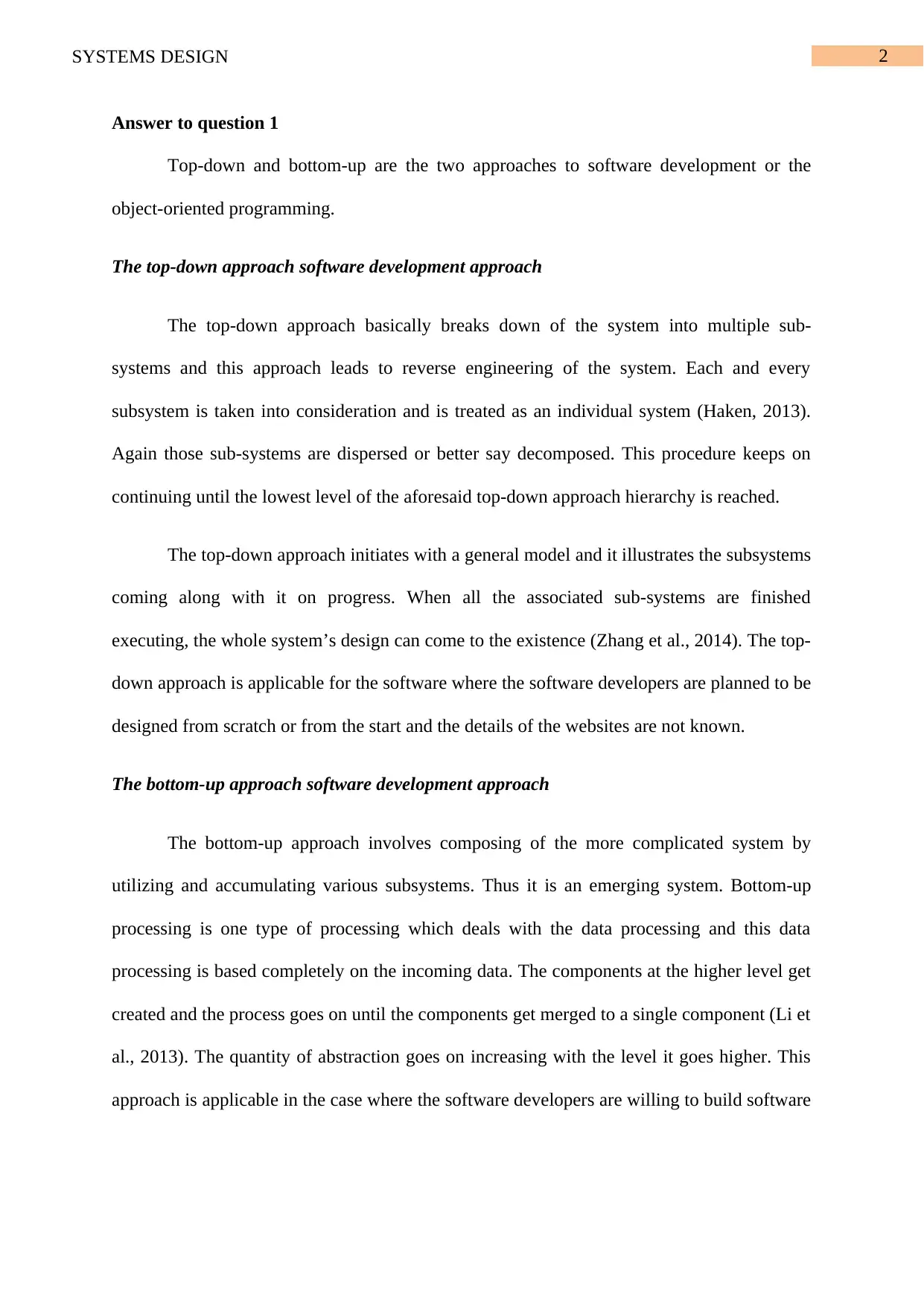
2SYSTEMS DESIGN
Answer to question 1
Top-down and bottom-up are the two approaches to software development or the
object-oriented programming.
The top-down approach software development approach
The top-down approach basically breaks down of the system into multiple sub-
systems and this approach leads to reverse engineering of the system. Each and every
subsystem is taken into consideration and is treated as an individual system (Haken, 2013).
Again those sub-systems are dispersed or better say decomposed. This procedure keeps on
continuing until the lowest level of the aforesaid top-down approach hierarchy is reached.
The top-down approach initiates with a general model and it illustrates the subsystems
coming along with it on progress. When all the associated sub-systems are finished
executing, the whole system’s design can come to the existence (Zhang et al., 2014). The top-
down approach is applicable for the software where the software developers are planned to be
designed from scratch or from the start and the details of the websites are not known.
The bottom-up approach software development approach
The bottom-up approach involves composing of the more complicated system by
utilizing and accumulating various subsystems. Thus it is an emerging system. Bottom-up
processing is one type of processing which deals with the data processing and this data
processing is based completely on the incoming data. The components at the higher level get
created and the process goes on until the components get merged to a single component (Li et
al., 2013). The quantity of abstraction goes on increasing with the level it goes higher. This
approach is applicable in the case where the software developers are willing to build software
Answer to question 1
Top-down and bottom-up are the two approaches to software development or the
object-oriented programming.
The top-down approach software development approach
The top-down approach basically breaks down of the system into multiple sub-
systems and this approach leads to reverse engineering of the system. Each and every
subsystem is taken into consideration and is treated as an individual system (Haken, 2013).
Again those sub-systems are dispersed or better say decomposed. This procedure keeps on
continuing until the lowest level of the aforesaid top-down approach hierarchy is reached.
The top-down approach initiates with a general model and it illustrates the subsystems
coming along with it on progress. When all the associated sub-systems are finished
executing, the whole system’s design can come to the existence (Zhang et al., 2014). The top-
down approach is applicable for the software where the software developers are planned to be
designed from scratch or from the start and the details of the websites are not known.
The bottom-up approach software development approach
The bottom-up approach involves composing of the more complicated system by
utilizing and accumulating various subsystems. Thus it is an emerging system. Bottom-up
processing is one type of processing which deals with the data processing and this data
processing is based completely on the incoming data. The components at the higher level get
created and the process goes on until the components get merged to a single component (Li et
al., 2013). The quantity of abstraction goes on increasing with the level it goes higher. This
approach is applicable in the case where the software developers are willing to build software
⊘ This is a preview!⊘
Do you want full access?
Subscribe today to unlock all pages.

Trusted by 1+ million students worldwide
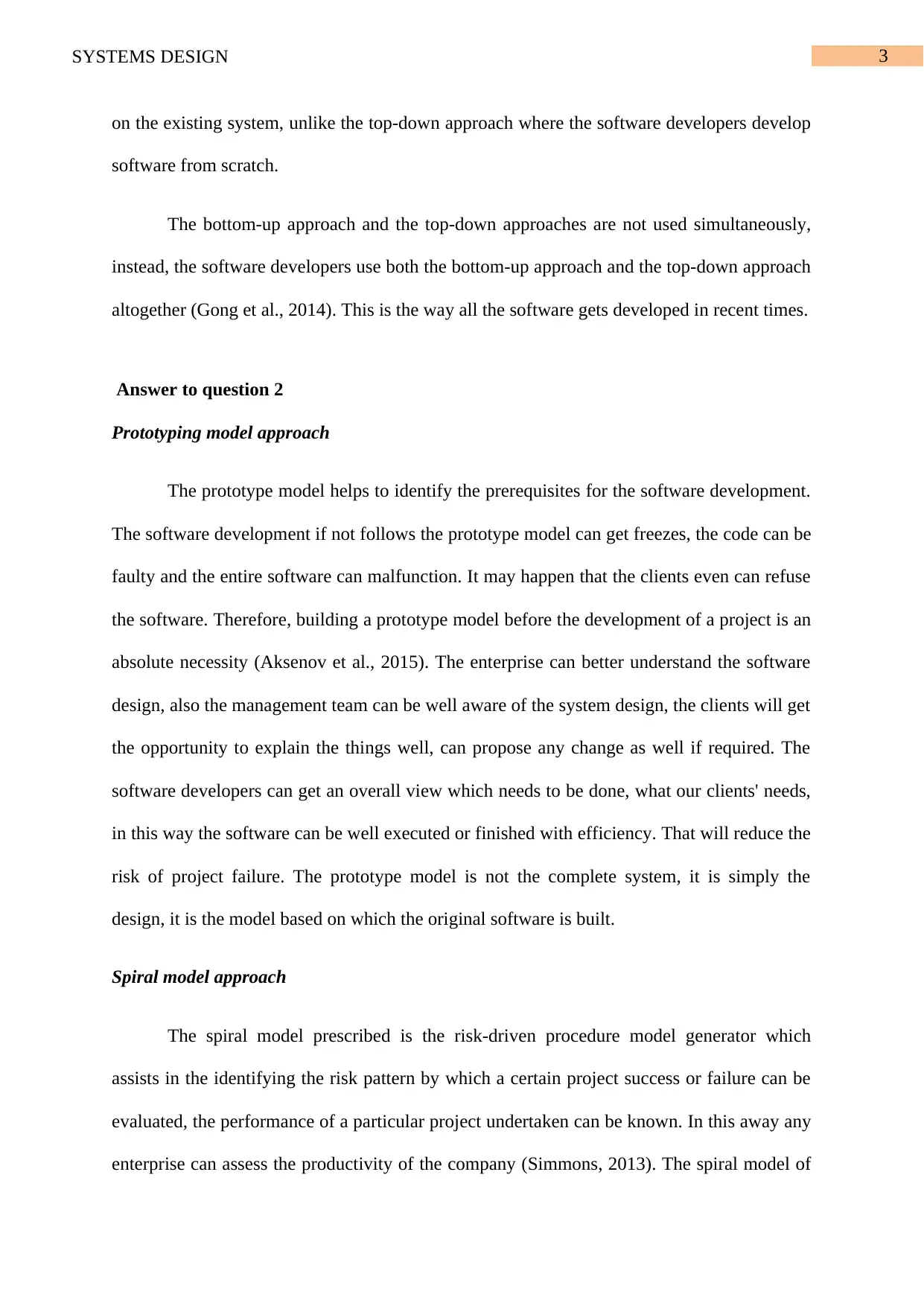
3SYSTEMS DESIGN
on the existing system, unlike the top-down approach where the software developers develop
software from scratch.
The bottom-up approach and the top-down approaches are not used simultaneously,
instead, the software developers use both the bottom-up approach and the top-down approach
altogether (Gong et al., 2014). This is the way all the software gets developed in recent times.
Answer to question 2
Prototyping model approach
The prototype model helps to identify the prerequisites for the software development.
The software development if not follows the prototype model can get freezes, the code can be
faulty and the entire software can malfunction. It may happen that the clients even can refuse
the software. Therefore, building a prototype model before the development of a project is an
absolute necessity (Aksenov et al., 2015). The enterprise can better understand the software
design, also the management team can be well aware of the system design, the clients will get
the opportunity to explain the things well, can propose any change as well if required. The
software developers can get an overall view which needs to be done, what our clients' needs,
in this way the software can be well executed or finished with efficiency. That will reduce the
risk of project failure. The prototype model is not the complete system, it is simply the
design, it is the model based on which the original software is built.
Spiral model approach
The spiral model prescribed is the risk-driven procedure model generator which
assists in the identifying the risk pattern by which a certain project success or failure can be
evaluated, the performance of a particular project undertaken can be known. In this away any
enterprise can assess the productivity of the company (Simmons, 2013). The spiral model of
on the existing system, unlike the top-down approach where the software developers develop
software from scratch.
The bottom-up approach and the top-down approaches are not used simultaneously,
instead, the software developers use both the bottom-up approach and the top-down approach
altogether (Gong et al., 2014). This is the way all the software gets developed in recent times.
Answer to question 2
Prototyping model approach
The prototype model helps to identify the prerequisites for the software development.
The software development if not follows the prototype model can get freezes, the code can be
faulty and the entire software can malfunction. It may happen that the clients even can refuse
the software. Therefore, building a prototype model before the development of a project is an
absolute necessity (Aksenov et al., 2015). The enterprise can better understand the software
design, also the management team can be well aware of the system design, the clients will get
the opportunity to explain the things well, can propose any change as well if required. The
software developers can get an overall view which needs to be done, what our clients' needs,
in this way the software can be well executed or finished with efficiency. That will reduce the
risk of project failure. The prototype model is not the complete system, it is simply the
design, it is the model based on which the original software is built.
Spiral model approach
The spiral model prescribed is the risk-driven procedure model generator which
assists in the identifying the risk pattern by which a certain project success or failure can be
evaluated, the performance of a particular project undertaken can be known. In this away any
enterprise can assess the productivity of the company (Simmons, 2013). The spiral model of
Paraphrase This Document
Need a fresh take? Get an instant paraphrase of this document with our AI Paraphraser
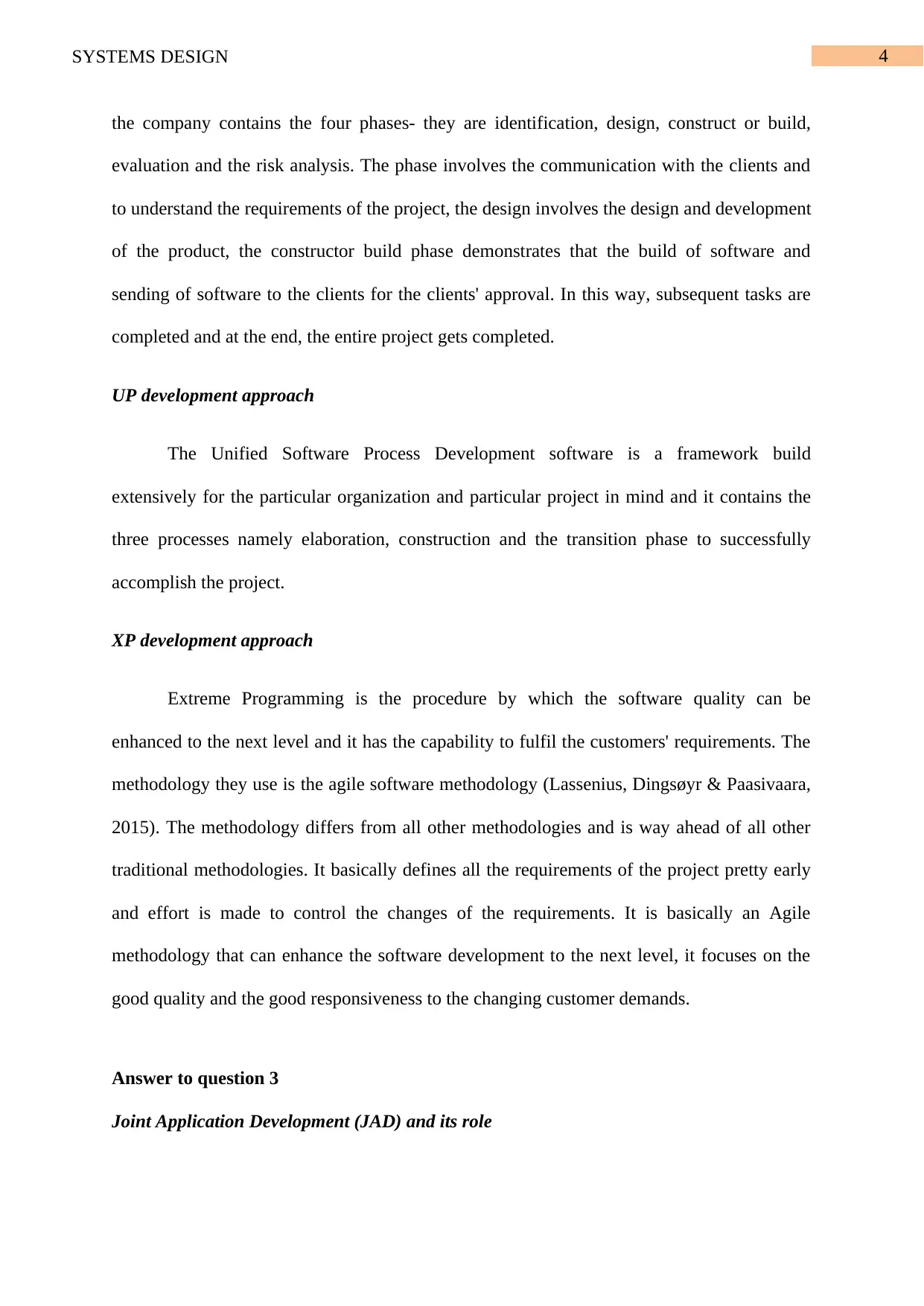
4SYSTEMS DESIGN
the company contains the four phases- they are identification, design, construct or build,
evaluation and the risk analysis. The phase involves the communication with the clients and
to understand the requirements of the project, the design involves the design and development
of the product, the constructor build phase demonstrates that the build of software and
sending of software to the clients for the clients' approval. In this way, subsequent tasks are
completed and at the end, the entire project gets completed.
UP development approach
The Unified Software Process Development software is a framework build
extensively for the particular organization and particular project in mind and it contains the
three processes namely elaboration, construction and the transition phase to successfully
accomplish the project.
XP development approach
Extreme Programming is the procedure by which the software quality can be
enhanced to the next level and it has the capability to fulfil the customers' requirements. The
methodology they use is the agile software methodology (Lassenius, Dingsøyr & Paasivaara,
2015). The methodology differs from all other methodologies and is way ahead of all other
traditional methodologies. It basically defines all the requirements of the project pretty early
and effort is made to control the changes of the requirements. It is basically an Agile
methodology that can enhance the software development to the next level, it focuses on the
good quality and the good responsiveness to the changing customer demands.
Answer to question 3
Joint Application Development (JAD) and its role
the company contains the four phases- they are identification, design, construct or build,
evaluation and the risk analysis. The phase involves the communication with the clients and
to understand the requirements of the project, the design involves the design and development
of the product, the constructor build phase demonstrates that the build of software and
sending of software to the clients for the clients' approval. In this way, subsequent tasks are
completed and at the end, the entire project gets completed.
UP development approach
The Unified Software Process Development software is a framework build
extensively for the particular organization and particular project in mind and it contains the
three processes namely elaboration, construction and the transition phase to successfully
accomplish the project.
XP development approach
Extreme Programming is the procedure by which the software quality can be
enhanced to the next level and it has the capability to fulfil the customers' requirements. The
methodology they use is the agile software methodology (Lassenius, Dingsøyr & Paasivaara,
2015). The methodology differs from all other methodologies and is way ahead of all other
traditional methodologies. It basically defines all the requirements of the project pretty early
and effort is made to control the changes of the requirements. It is basically an Agile
methodology that can enhance the software development to the next level, it focuses on the
good quality and the good responsiveness to the changing customer demands.
Answer to question 3
Joint Application Development (JAD) and its role
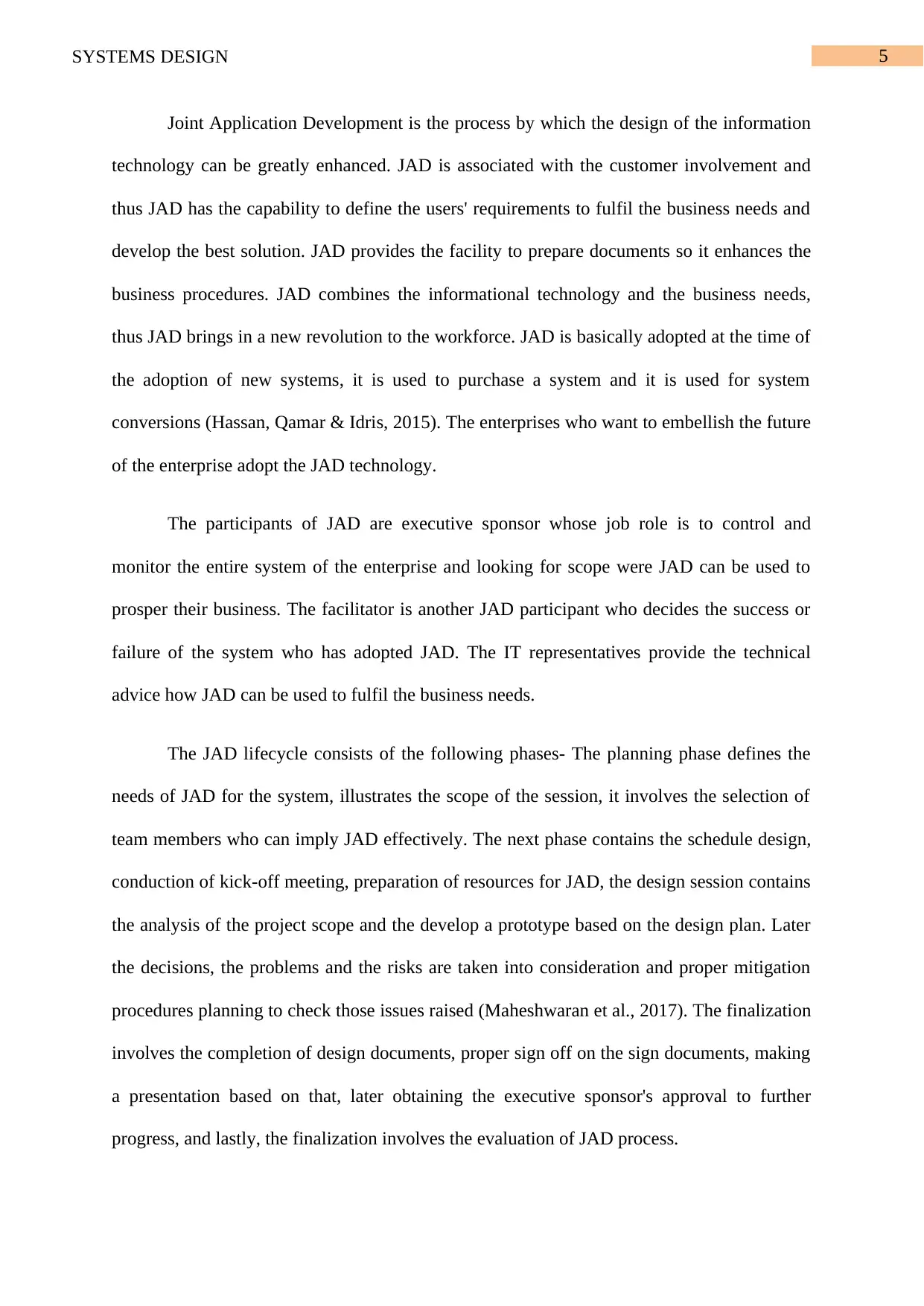
5SYSTEMS DESIGN
Joint Application Development is the process by which the design of the information
technology can be greatly enhanced. JAD is associated with the customer involvement and
thus JAD has the capability to define the users' requirements to fulfil the business needs and
develop the best solution. JAD provides the facility to prepare documents so it enhances the
business procedures. JAD combines the informational technology and the business needs,
thus JAD brings in a new revolution to the workforce. JAD is basically adopted at the time of
the adoption of new systems, it is used to purchase a system and it is used for system
conversions (Hassan, Qamar & Idris, 2015). The enterprises who want to embellish the future
of the enterprise adopt the JAD technology.
The participants of JAD are executive sponsor whose job role is to control and
monitor the entire system of the enterprise and looking for scope were JAD can be used to
prosper their business. The facilitator is another JAD participant who decides the success or
failure of the system who has adopted JAD. The IT representatives provide the technical
advice how JAD can be used to fulfil the business needs.
The JAD lifecycle consists of the following phases- The planning phase defines the
needs of JAD for the system, illustrates the scope of the session, it involves the selection of
team members who can imply JAD effectively. The next phase contains the schedule design,
conduction of kick-off meeting, preparation of resources for JAD, the design session contains
the analysis of the project scope and the develop a prototype based on the design plan. Later
the decisions, the problems and the risks are taken into consideration and proper mitigation
procedures planning to check those issues raised (Maheshwaran et al., 2017). The finalization
involves the completion of design documents, proper sign off on the sign documents, making
a presentation based on that, later obtaining the executive sponsor's approval to further
progress, and lastly, the finalization involves the evaluation of JAD process.
Joint Application Development is the process by which the design of the information
technology can be greatly enhanced. JAD is associated with the customer involvement and
thus JAD has the capability to define the users' requirements to fulfil the business needs and
develop the best solution. JAD provides the facility to prepare documents so it enhances the
business procedures. JAD combines the informational technology and the business needs,
thus JAD brings in a new revolution to the workforce. JAD is basically adopted at the time of
the adoption of new systems, it is used to purchase a system and it is used for system
conversions (Hassan, Qamar & Idris, 2015). The enterprises who want to embellish the future
of the enterprise adopt the JAD technology.
The participants of JAD are executive sponsor whose job role is to control and
monitor the entire system of the enterprise and looking for scope were JAD can be used to
prosper their business. The facilitator is another JAD participant who decides the success or
failure of the system who has adopted JAD. The IT representatives provide the technical
advice how JAD can be used to fulfil the business needs.
The JAD lifecycle consists of the following phases- The planning phase defines the
needs of JAD for the system, illustrates the scope of the session, it involves the selection of
team members who can imply JAD effectively. The next phase contains the schedule design,
conduction of kick-off meeting, preparation of resources for JAD, the design session contains
the analysis of the project scope and the develop a prototype based on the design plan. Later
the decisions, the problems and the risks are taken into consideration and proper mitigation
procedures planning to check those issues raised (Maheshwaran et al., 2017). The finalization
involves the completion of design documents, proper sign off on the sign documents, making
a presentation based on that, later obtaining the executive sponsor's approval to further
progress, and lastly, the finalization involves the evaluation of JAD process.
⊘ This is a preview!⊘
Do you want full access?
Subscribe today to unlock all pages.

Trusted by 1+ million students worldwide
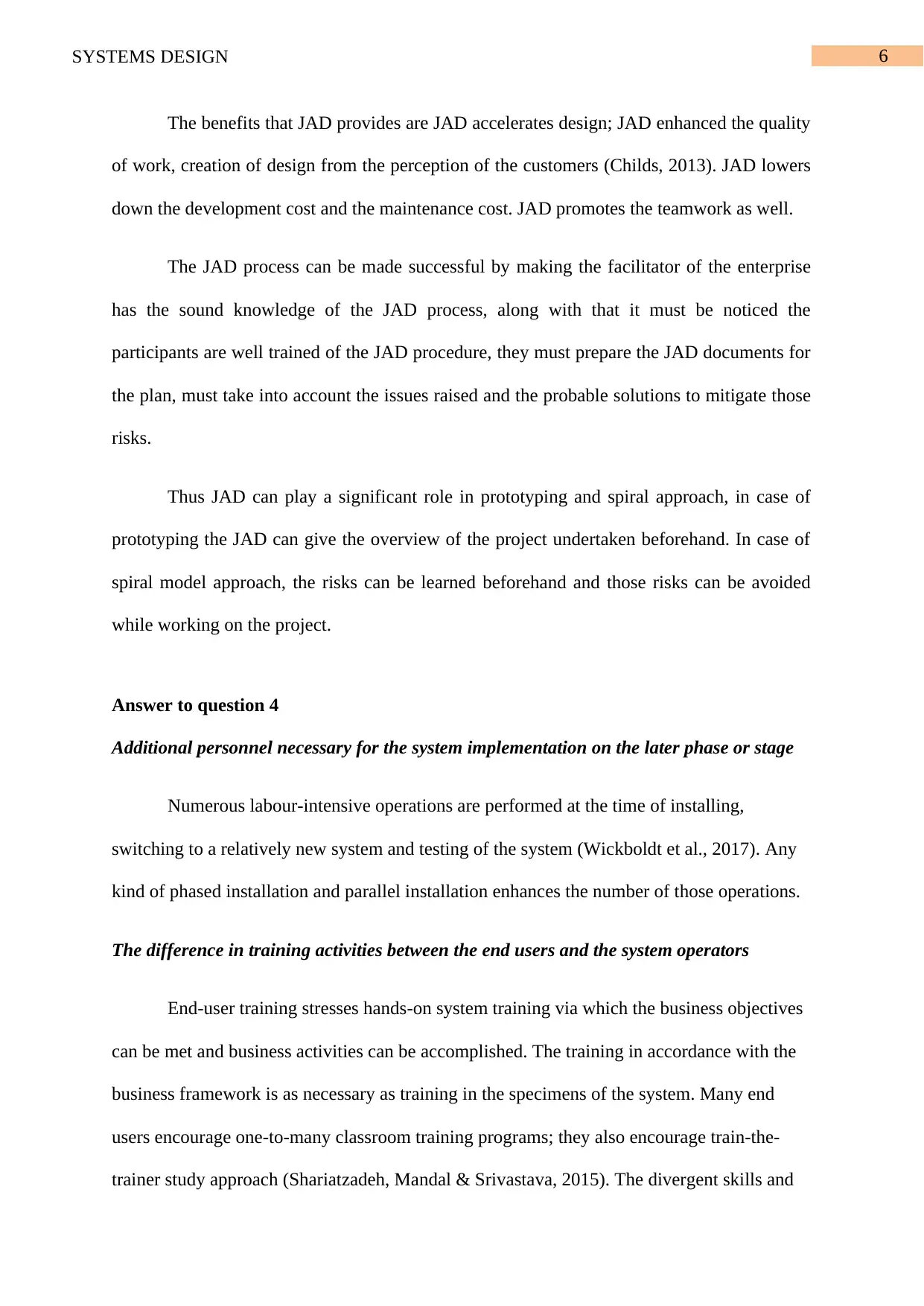
6SYSTEMS DESIGN
The benefits that JAD provides are JAD accelerates design; JAD enhanced the quality
of work, creation of design from the perception of the customers (Childs, 2013). JAD lowers
down the development cost and the maintenance cost. JAD promotes the teamwork as well.
The JAD process can be made successful by making the facilitator of the enterprise
has the sound knowledge of the JAD process, along with that it must be noticed the
participants are well trained of the JAD procedure, they must prepare the JAD documents for
the plan, must take into account the issues raised and the probable solutions to mitigate those
risks.
Thus JAD can play a significant role in prototyping and spiral approach, in case of
prototyping the JAD can give the overview of the project undertaken beforehand. In case of
spiral model approach, the risks can be learned beforehand and those risks can be avoided
while working on the project.
Answer to question 4
Additional personnel necessary for the system implementation on the later phase or stage
Numerous labour-intensive operations are performed at the time of installing,
switching to a relatively new system and testing of the system (Wickboldt et al., 2017). Any
kind of phased installation and parallel installation enhances the number of those operations.
The difference in training activities between the end users and the system operators
End-user training stresses hands-on system training via which the business objectives
can be met and business activities can be accomplished. The training in accordance with the
business framework is as necessary as training in the specimens of the system. Many end
users encourage one-to-many classroom training programs; they also encourage train-the-
trainer study approach (Shariatzadeh, Mandal & Srivastava, 2015). The divergent skills and
The benefits that JAD provides are JAD accelerates design; JAD enhanced the quality
of work, creation of design from the perception of the customers (Childs, 2013). JAD lowers
down the development cost and the maintenance cost. JAD promotes the teamwork as well.
The JAD process can be made successful by making the facilitator of the enterprise
has the sound knowledge of the JAD process, along with that it must be noticed the
participants are well trained of the JAD procedure, they must prepare the JAD documents for
the plan, must take into account the issues raised and the probable solutions to mitigate those
risks.
Thus JAD can play a significant role in prototyping and spiral approach, in case of
prototyping the JAD can give the overview of the project undertaken beforehand. In case of
spiral model approach, the risks can be learned beforehand and those risks can be avoided
while working on the project.
Answer to question 4
Additional personnel necessary for the system implementation on the later phase or stage
Numerous labour-intensive operations are performed at the time of installing,
switching to a relatively new system and testing of the system (Wickboldt et al., 2017). Any
kind of phased installation and parallel installation enhances the number of those operations.
The difference in training activities between the end users and the system operators
End-user training stresses hands-on system training via which the business objectives
can be met and business activities can be accomplished. The training in accordance with the
business framework is as necessary as training in the specimens of the system. Many end
users encourage one-to-many classroom training programs; they also encourage train-the-
trainer study approach (Shariatzadeh, Mandal & Srivastava, 2015). The divergent skills and
Paraphrase This Document
Need a fresh take? Get an instant paraphrase of this document with our AI Paraphraser
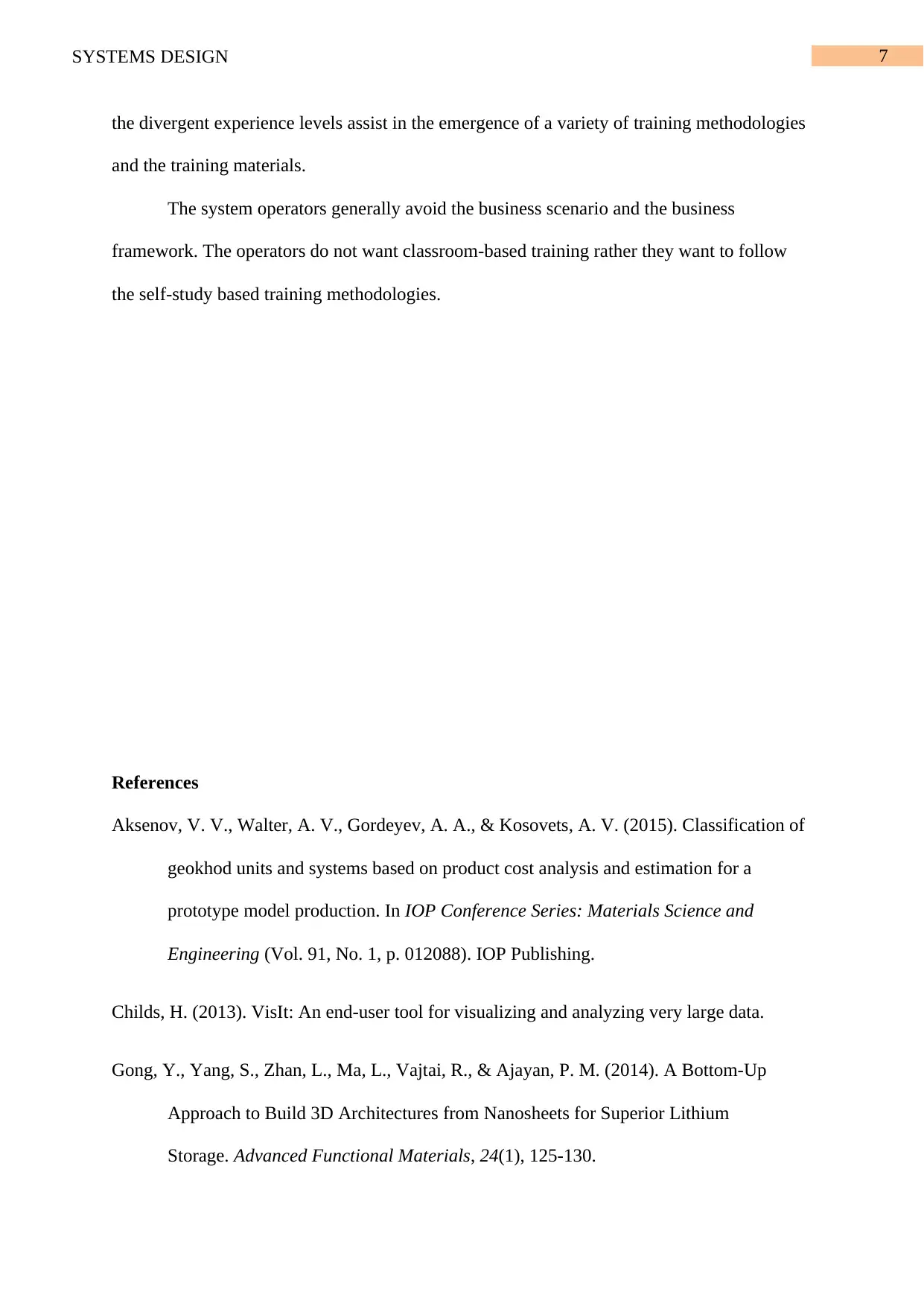
7SYSTEMS DESIGN
the divergent experience levels assist in the emergence of a variety of training methodologies
and the training materials.
The system operators generally avoid the business scenario and the business
framework. The operators do not want classroom-based training rather they want to follow
the self-study based training methodologies.
References
Aksenov, V. V., Walter, A. V., Gordeyev, A. A., & Kosovets, A. V. (2015). Classification of
geokhod units and systems based on product cost analysis and estimation for a
prototype model production. In IOP Conference Series: Materials Science and
Engineering (Vol. 91, No. 1, p. 012088). IOP Publishing.
Childs, H. (2013). VisIt: An end-user tool for visualizing and analyzing very large data.
Gong, Y., Yang, S., Zhan, L., Ma, L., Vajtai, R., & Ajayan, P. M. (2014). A Bottom‐Up
Approach to Build 3D Architectures from Nanosheets for Superior Lithium
Storage. Advanced Functional Materials, 24(1), 125-130.
the divergent experience levels assist in the emergence of a variety of training methodologies
and the training materials.
The system operators generally avoid the business scenario and the business
framework. The operators do not want classroom-based training rather they want to follow
the self-study based training methodologies.
References
Aksenov, V. V., Walter, A. V., Gordeyev, A. A., & Kosovets, A. V. (2015). Classification of
geokhod units and systems based on product cost analysis and estimation for a
prototype model production. In IOP Conference Series: Materials Science and
Engineering (Vol. 91, No. 1, p. 012088). IOP Publishing.
Childs, H. (2013). VisIt: An end-user tool for visualizing and analyzing very large data.
Gong, Y., Yang, S., Zhan, L., Ma, L., Vajtai, R., & Ajayan, P. M. (2014). A Bottom‐Up
Approach to Build 3D Architectures from Nanosheets for Superior Lithium
Storage. Advanced Functional Materials, 24(1), 125-130.
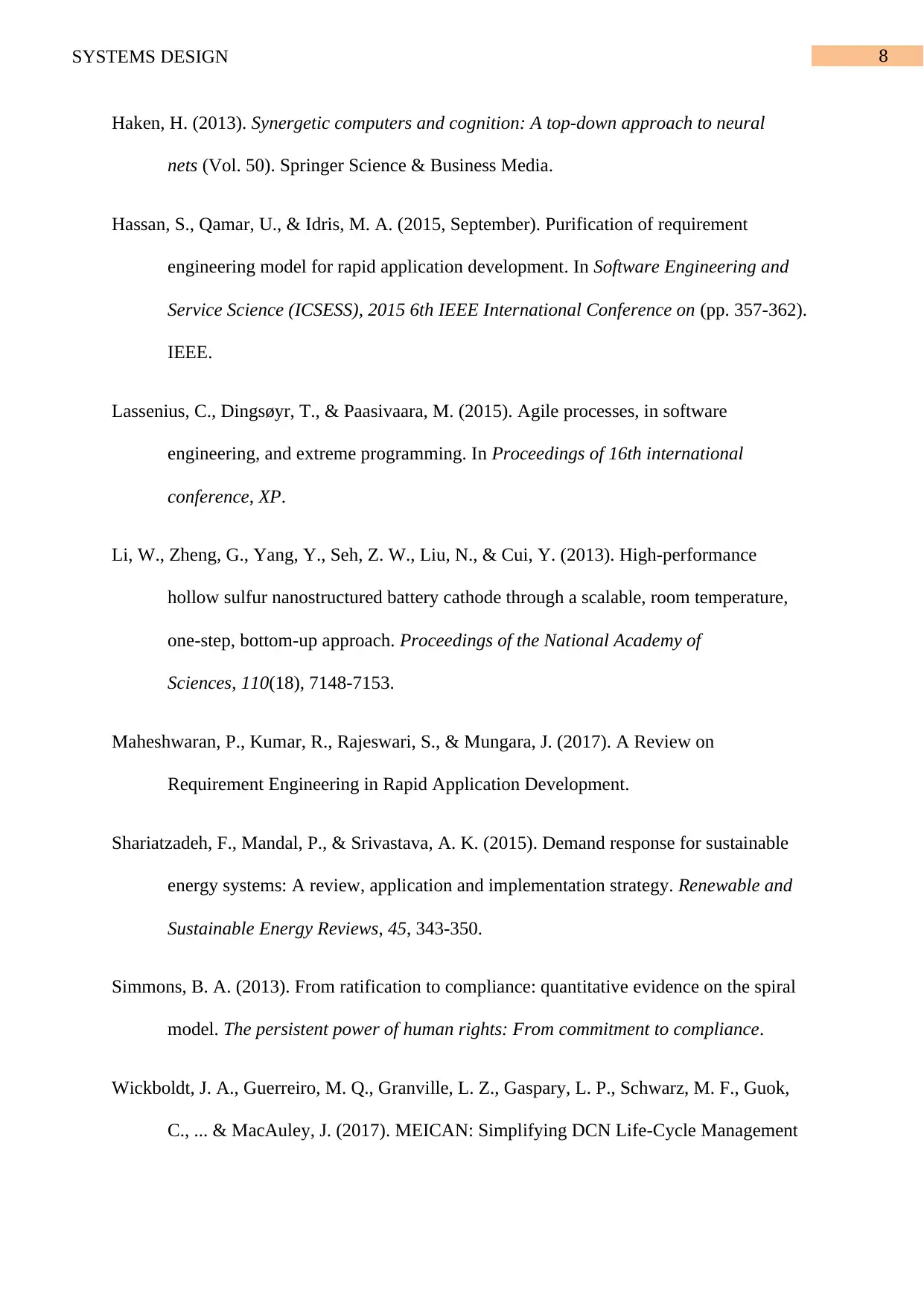
8SYSTEMS DESIGN
Haken, H. (2013). Synergetic computers and cognition: A top-down approach to neural
nets (Vol. 50). Springer Science & Business Media.
Hassan, S., Qamar, U., & Idris, M. A. (2015, September). Purification of requirement
engineering model for rapid application development. In Software Engineering and
Service Science (ICSESS), 2015 6th IEEE International Conference on (pp. 357-362).
IEEE.
Lassenius, C., Dingsøyr, T., & Paasivaara, M. (2015). Agile processes, in software
engineering, and extreme programming. In Proceedings of 16th international
conference, XP.
Li, W., Zheng, G., Yang, Y., Seh, Z. W., Liu, N., & Cui, Y. (2013). High-performance
hollow sulfur nanostructured battery cathode through a scalable, room temperature,
one-step, bottom-up approach. Proceedings of the National Academy of
Sciences, 110(18), 7148-7153.
Maheshwaran, P., Kumar, R., Rajeswari, S., & Mungara, J. (2017). A Review on
Requirement Engineering in Rapid Application Development.
Shariatzadeh, F., Mandal, P., & Srivastava, A. K. (2015). Demand response for sustainable
energy systems: A review, application and implementation strategy. Renewable and
Sustainable Energy Reviews, 45, 343-350.
Simmons, B. A. (2013). From ratification to compliance: quantitative evidence on the spiral
model. The persistent power of human rights: From commitment to compliance.
Wickboldt, J. A., Guerreiro, M. Q., Granville, L. Z., Gaspary, L. P., Schwarz, M. F., Guok,
C., ... & MacAuley, J. (2017). MEICAN: Simplifying DCN Life-Cycle Management
Haken, H. (2013). Synergetic computers and cognition: A top-down approach to neural
nets (Vol. 50). Springer Science & Business Media.
Hassan, S., Qamar, U., & Idris, M. A. (2015, September). Purification of requirement
engineering model for rapid application development. In Software Engineering and
Service Science (ICSESS), 2015 6th IEEE International Conference on (pp. 357-362).
IEEE.
Lassenius, C., Dingsøyr, T., & Paasivaara, M. (2015). Agile processes, in software
engineering, and extreme programming. In Proceedings of 16th international
conference, XP.
Li, W., Zheng, G., Yang, Y., Seh, Z. W., Liu, N., & Cui, Y. (2013). High-performance
hollow sulfur nanostructured battery cathode through a scalable, room temperature,
one-step, bottom-up approach. Proceedings of the National Academy of
Sciences, 110(18), 7148-7153.
Maheshwaran, P., Kumar, R., Rajeswari, S., & Mungara, J. (2017). A Review on
Requirement Engineering in Rapid Application Development.
Shariatzadeh, F., Mandal, P., & Srivastava, A. K. (2015). Demand response for sustainable
energy systems: A review, application and implementation strategy. Renewable and
Sustainable Energy Reviews, 45, 343-350.
Simmons, B. A. (2013). From ratification to compliance: quantitative evidence on the spiral
model. The persistent power of human rights: From commitment to compliance.
Wickboldt, J. A., Guerreiro, M. Q., Granville, L. Z., Gaspary, L. P., Schwarz, M. F., Guok,
C., ... & MacAuley, J. (2017). MEICAN: Simplifying DCN Life-Cycle Management
⊘ This is a preview!⊘
Do you want full access?
Subscribe today to unlock all pages.

Trusted by 1+ million students worldwide

9SYSTEMS DESIGN
from End-User and Operator Perspectives in Inter-Domain Environments. IEEE
Communications Magazine.
Zhang, X., Yang, L. T., Liu, C., & Chen, J. (2014). A scalable two-phase top-down
specialization approach for data anonymization using mapreduce on cloud. IEEE
Transactions on Parallel and Distributed Systems, 25(2), 363-373.
from End-User and Operator Perspectives in Inter-Domain Environments. IEEE
Communications Magazine.
Zhang, X., Yang, L. T., Liu, C., & Chen, J. (2014). A scalable two-phase top-down
specialization approach for data anonymization using mapreduce on cloud. IEEE
Transactions on Parallel and Distributed Systems, 25(2), 363-373.
1 out of 10
Related Documents
Your All-in-One AI-Powered Toolkit for Academic Success.
+13062052269
info@desklib.com
Available 24*7 on WhatsApp / Email
![[object Object]](/_next/static/media/star-bottom.7253800d.svg)
Unlock your academic potential
Copyright © 2020–2025 A2Z Services. All Rights Reserved. Developed and managed by ZUCOL.





